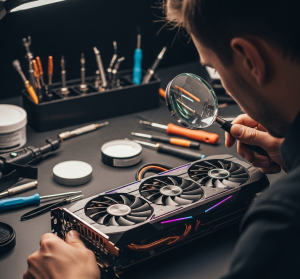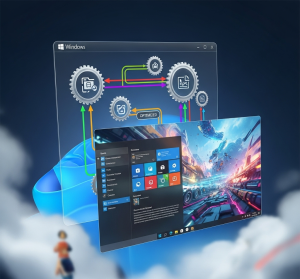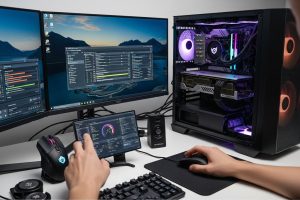Experience Gaming Like Never Before: The Ultimate PC Optimization Guide
Introduction
Are you a passionate gamer constantly seeking that elusive edge? Do you dream of buttery-smooth frame rates, lightning-fast load times, and an immersive experience free from lag and stutter? The good news is, achieving peak gaming performance isn’t just for professional esports players. With the right strategies and tools, you can transform your current PC into a formidable gaming rig, unlocking its true potential. This guide will walk you through essential optimization techniques, from hardware tweaks to software configurations, ensuring your gaming sessions are nothing short of epic.
 The Foundation: Hardware Health and Upgrades
The Foundation: Hardware Health and Upgrades
Before diving into software wizardry, let’s ensure your hardware is up to snuff. Even the most optimized software can’t compensate for an underperforming or bottlenecked system.
Keep Your Drivers Updated
This is often overlooked but critically important. Graphics card drivers, in particular, receive frequent updates that include performance enhancements and bug fixes for the latest games. Regularly check NVIDIA, AMD, or Intel’s websites for the newest drivers. Don’t forget chipset drivers and other peripheral drivers too.
Monitor Temperatures
Overheating is a silent killer of performance. High temperatures can lead to thermal throttling, where your components intentionally slow down to prevent damage. Use monitoring software (like HWMonitor or MSI Afterburner) to keep an eye on your CPU and GPU temperatures. If they’re consistently hitting high numbers (e.g., above 85°C under load), consider improving your cooling solution, whether it’s better case airflow, a new CPU cooler, or even liquid cooling.
RAM: Quantity and Speed Matter
For modern gaming, 16GB of RAM is generally the sweet spot. If you’re still on 8GB, an upgrade can significantly reduce stuttering and improve overall system responsiveness, especially in open-world titles. Furthermore, RAM speed (measured in MHz) and timings (CL values) can impact performance. Ensure your RAM is running at its advertised speed by enabling the XMP (Extreme Memory Profile) or DOCP (DRAM Overclocking Profile) in your motherboard’s BIOS.
Storage: SSDs are Non-Negotiable
If you’re still gaming on a traditional Hard Disk Drive (HDD), you’re missing out on a massive performance boost. Solid State Drives (SSDs), especially NVMe SSDs, offer drastically faster load times for games and the operating system. Installing your favorite games on an SSD will significantly cut down on waiting and get you into the action faster.
 Software Synergy: Optimizing Windows and Your Games
Software Synergy: Optimizing Windows and Your Games
With your hardware humming, it’s time to fine-tune your software environment.
Power Plan Optimization
Windows’ default power plans aren’t always optimized for gaming. Navigate to “Power Options” in the Control Panel and select “High Performance” or “Ultimate Performance” (if available). This ensures your CPU doesn’t throttle down during intense gaming sessions.
Disable Background Processes
Many applications love to run in the background, silently consuming precious CPU cycles and RAM. Open Task Manager (Ctrl+Shift+Esc), go to the “Processes” tab, and identify any resource-hogging applications you don’t need while gaming. You can also disable unnecessary startup programs in the “Startup” tab.
Adjust In-Game Settings
This might seem obvious, but understanding how each graphical setting impacts performance is crucial. Experiment with settings like resolution, anti-aliasing, shadow quality, and texture quality. Often, a slight reduction in one or two settings can yield a significant FPS boost without a noticeable drop in visual fidelity. Prioritize settings that directly affect gameplay smoothness over purely aesthetic ones.
Leverage a Gaming Browser
Traditional browsers can be resource vampires, especially if you have multiple tabs open, streams running, or extensions active. A specialized gaming browser is designed to minimize resource usage, leaving more RAM and CPU cycles for your games. Many offer features like RAM and CPU limiters, integrated ad blockers, and even network prioritization to reduce latency. Consider trying a browser built for gamers, like Opera GX which allows you to manage system resources and even integrates with popular gaming platforms.
Disk Cleanup and Defragmentation (for HDDs)
Regularly clear out temporary files and junk using Windows Disk Cleanup. If you still use an HDD for some games, defragmenting it occasionally can help with load times, though this is not necessary for SSDs (and can even reduce their lifespan).
 Advanced Tweaks for the Enthusiast
Advanced Tweaks for the Enthusiast
For those who want to go the extra mile:
Overclocking (with caution!)
If you have unlocked hardware (e.g., “K” series Intel CPUs, “X” or “XT” series AMD CPUs, or most GPUs), overclocking can provide a measurable performance increase. However, this carries risks of instability and potential hardware damage if not done correctly. Research thoroughly and proceed with caution, ensuring adequate cooling.
Clean Windows Installation
Sometimes, the simplest solution is the most effective. A fresh installation of Windows can eliminate years of accumulated bloatware, fragmented files, and registry errors, providing a clean slate for optimal performance.
Conclusion:
Optimizing your PC for gaming is an ongoing process, not a one-time fix. By consistently applying these tips – from driver updates to in-game settings adjustments and leveraging tools like a gaming-focused browser – you’ll ensure your system is always ready to deliver the best possible gaming experience. Don’t let technical bottlenecks hold you back. Take control, unleash your PC’s power, and dive into your favorite virtual worlds with unparalleled smoothness and immersion.
Ready to level up your gaming experience? Start optimizing your PC today and rediscover the joy of fluid, high-performance gameplay!



